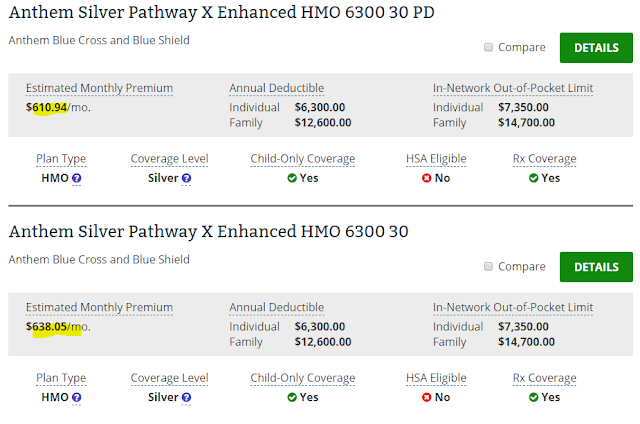To return to a point I addled somewhat last week...
Applicants for health insurance on HealthCare.gov, the federal platform used by 39 states, are prompted to identify their race, and separately, whether they are of Hispanic/Latino "ethnicity." The questions are optional. Race is reported as unknown for 30% of enrollees, and ethnicity as unknown for 25%. The data is self-reported and somewhat volatile. I've been warned it should be taken with a grain of salt -- or considerably more.
That said, in 2018 self-identified Hispanic/Latino enrollment on HealthCare.gov is up 8% compared to 2017, to 1,033,699, and up 12.7% from 2016. Overall enrollment on HealthCare.gov is down 9% since 2016, to 8,743,642. Those self-reporting as Hispanic in 2016 accounted for 9.5% of total enrollment on HealthCare.gov; in 2018, they accounted for 11.8%.
[Update, 8/25/18]: in 2016, ethnicity was not broken out separately from race, and a larger percentage of race was reported as "unknown" than in subsequent years. In 2017, moreover, when ethnicity was broken out separately, there was no "unknown" category -- simply Hispanic/not Hispanic. The comparison with 2016 seems particularly suspect, since race and ethnicity were rolled together. ]
In Florida, the state with the highest ACA marketplace enrollment and the highest takeup among those who are subsidy-eligible, Hispanic enrollment was way up in 2018, from 327,965 to 378,471. That's a 15% increase, and accounts for most of the 39-state increase. Overall Florida enrollment was down 2.5%. In Miami-Dade County, however, which is about two thirds Hispanic, enrollment was up by about 7,000, to 394,677. In Osceola County, 45% Hispanic, enrollment was up about 1,700, to 40,414.
Here is Hispanic and total enrollment, 2018 vs. 2017, in the 10 Florida counties with the highest Hispanic enrollment this year. In all of them, Hispanic enrollment is up this year -- not surprising given the large overall increase.
Applicants for health insurance on HealthCare.gov, the federal platform used by 39 states, are prompted to identify their race, and separately, whether they are of Hispanic/Latino "ethnicity." The questions are optional. Race is reported as unknown for 30% of enrollees, and ethnicity as unknown for 25%. The data is self-reported and somewhat volatile. I've been warned it should be taken with a grain of salt -- or considerably more.
That said, in 2018 self-identified Hispanic/Latino enrollment on HealthCare.gov is up 8% compared to 2017, to 1,033,699, and up 12.7% from 2016. Overall enrollment on HealthCare.gov is down 9% since 2016, to 8,743,642. Those self-reporting as Hispanic in 2016 accounted for 9.5% of total enrollment on HealthCare.gov; in 2018, they accounted for 11.8%.
[Update, 8/25/18]: in 2016, ethnicity was not broken out separately from race, and a larger percentage of race was reported as "unknown" than in subsequent years. In 2017, moreover, when ethnicity was broken out separately, there was no "unknown" category -- simply Hispanic/not Hispanic. The comparison with 2016 seems particularly suspect, since race and ethnicity were rolled together. ]
In Florida, the state with the highest ACA marketplace enrollment and the highest takeup among those who are subsidy-eligible, Hispanic enrollment was way up in 2018, from 327,965 to 378,471. That's a 15% increase, and accounts for most of the 39-state increase. Overall Florida enrollment was down 2.5%. In Miami-Dade County, however, which is about two thirds Hispanic, enrollment was up by about 7,000, to 394,677. In Osceola County, 45% Hispanic, enrollment was up about 1,700, to 40,414.
Here is Hispanic and total enrollment, 2018 vs. 2017, in the 10 Florida counties with the highest Hispanic enrollment this year. In all of them, Hispanic enrollment is up this year -- not surprising given the large overall increase.
